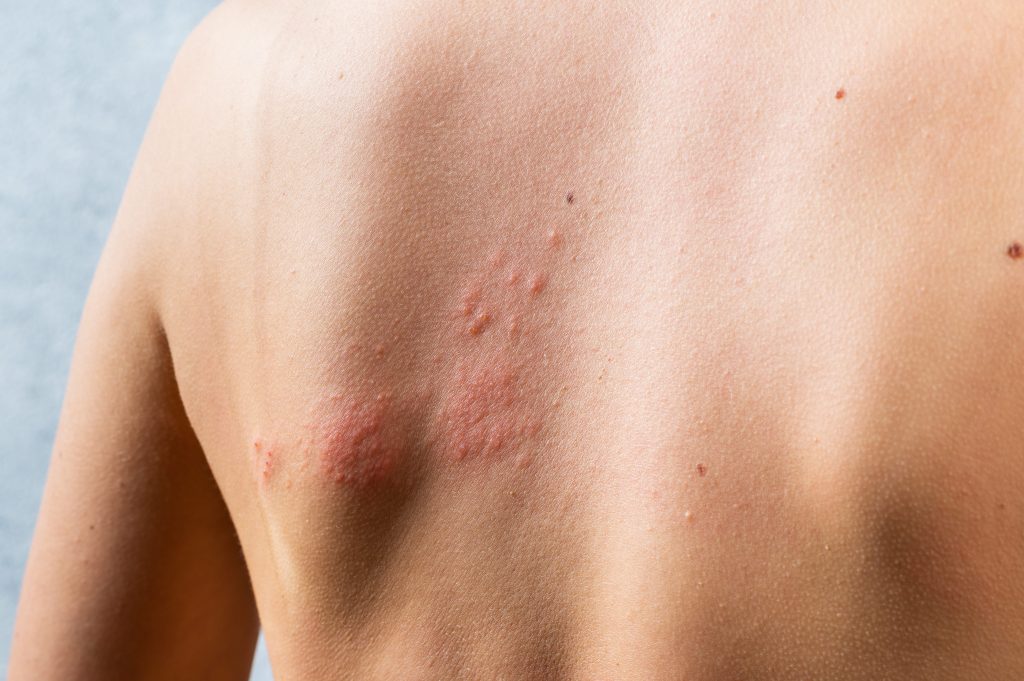Back to General Dermatology

What is Shingles?
Shingles is a viral infection that occurs as a reactivation of the varicella-zoster virus, which lies dormant in the nerve tissues after a previous chickenpox infection. The virus can become active again years later, resulting in shingles. Shingles typically manifest as a cluster of painful blisters on a pink/red base that follows the distribution of a specific nerve on one side of the body.
Symptoms of Shingles
- Pain and Sensitivity: The first sign of shingles is often a localized area of pain, tingling, or burning sensation, limited to one side of the body. This is usually followed by the appearance of a rash. Long term nerve damage and pain may result from shingles.
- Rash: Clusters of blisters on a pink/red background appear after the initial pain, typically in a band or strip along one side of the body. The rash may be accompanied by itching.
- Other Symptoms: Some individuals may experience additional symptoms such as fever, headache, fatigue, and sensitivity to light. Shingles can involve the eye and can result in vision changes.
Causes and Risk Factors
- Varicella-Zoster Virus Reactivation: The varicella-zoster virus can reactivate due to factors such as age, weakened immune system, stress, or certain medical conditions.
- Previous Chickenpox Infection: Individuals who have had chickenpox are at risk of developing shingles later in life.
- Age: Shingles is more common in older adults, typically occurring after the age of 50.
- Weakened Immune System: People with weakened immune systems, such as those undergoing immunosuppressive therapy, have an increased risk of shingles.
Management and Treatment
- Antiviral Medications: Early treatment with antiviral medications (acyclovir and valacyclovir) can help reduce the severity and duration of shingles symptoms. These medications work by suppressing the replication of the virus.
- Pain Relief: Over-the-counter pain relievers such as acetaminophen or nonsteroidal anti-inflammatory drugs (NSAIDs) can help alleviate pain and discomfort.
- Topical Treatments: Applying calamine lotion or using topical creams containing lidocaine can provide relief from itching and discomfort.
- Cool Compresses: Cool compresses or baths can help soothe the affected area and reduce inflammation.
- Rest and Self-Care: Adequate rest, maintaining good hygiene, and avoiding scratching the rash can aid in the healing process.
- Vaccination: The shingles vaccine is available for individuals aged 50 years and older to prevent or reduce the severity of shingles and its complications. Similarly, the varicella (chickenpox) vaccine in childhood has drastically decreased the incidence of shingles later in life.
Complications and When to Seek Medical Care
- Postherpetic Neuralgia: Shingles can sometimes lead to long-lasting nerve pain known as postherpetic neuralgia (PHN). Seeking early medical attention can help reduce the risk of PHN.
- Other Complications: Although rare, shingles can lead to complications affecting the eyes, ears, or other organs. Immediate medical attention is necessary if symptoms extend beyond the rash.
Shingles is a viral infection that can cause significant discomfort. Early recognition and management are crucial to minimize symptoms and prevent long-term complications. If you suspect you have shingles or are experiencing symptoms, please call to schedule an appointment with one of our highly skilled board-certified medical providers to determine the most suitable treatment plan.
